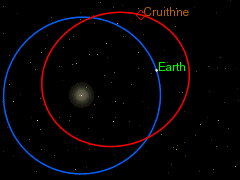Quasi-satellite
A quasi-satellite is an object in a 1:1 orbital resonance with its planet that stays close to the planet over many orbital periods.
A quasi-satellite's orbit around the Sun takes exactly the same time as the planet's, but has a different eccentricity (usually greater), as shown in the diagram on the right. When viewed from the perspective of the planet the quasi-satellite will appear to travel in an oblong retrograde loop around the planet.
In contrast to true satellites, quasi-satellite orbits lie outside the planet's Hill sphere, and are unstable. Over time they tend to evolve to other types of resonant motion, where they no longer remain in the planet's neighbourhood, then possibly later move back to a quasi-satellite orbit, etc.
Other types of orbit in a 1:1 resonance with the planet, include horseshoe orbits and tadpole orbits around the Lagrangian points, but objects in these orbits do not stay near the planet's longitude over many revolutions about the star. Objects in horseshoe orbits are known to sometimes periodically transfer to a relatively short-lived quasi-satellite orbit,[1] and are sometimes confused with them. An example of such an object is 2002 AA29.
Examples

- Earth
Earth currently has four known quasi-satellites: 3753 Cruithne, 2002 AA29, 2003 YN107,[citation needed] and 2004 GU9.[citation needed] These objects remain in quasi-satellite orbits for times of tens to hundreds of years.[1]
- Venus
Venus also has a quasi-satellite, 2002 VE68. This asteroid is also a Mercury- and Earth-crosser; it seems to have been a "companion" to Venus for the last 7000 years or so only, and is destined to be ejected from this orbital arrangement about 500 years from now.[2]
- Other planets
Based on simulations it is believed that Uranus and Neptune could potentially hold quasi-satellites for the age of the solar system (about 4.5 billion years),[3] but a quasi-satellite's orbit would remain stable for only 10 million years around Jupiter and 100,000 years around Saturn. No actual quasi-satellites of these planets are currently known.
- Artificial
In early 1989, the Soviet Phobos 2 spacecraft was injected into a quasi-satellite orbit around the Martian moon Phobos, with a mean orbital radius of about 100 km from Phobos.[4] According to computations, it could have then stayed trapped in the vicinity of Phobos for many months. The spacecraft was lost due to a malfunction of the on-board control system.
See also
References
- ^ a b M. Connors; et al. (2002). "Discovery of an asteroid and quasi-satellite in an Earth-like horseshoe orbit". Meteoritics & Planetary Science. 37: 1435. doi:10.1111/j.1945-5100.2002.tb01039.x.
{{cite journal}}: Explicit use of et al. in:|author=(help) - ^ Asteroid 2002 VE68, a quasi-satellite of Venus
- ^ P. Wiegert and K. Innanen (2000). "The stability of quasi satellites in the outer solar system". The Astronomical Journal. 119 (4): 1978–1984. doi:10.1086/301291.
- ^ The orbit is erroneously called "quasi-synchronous"
